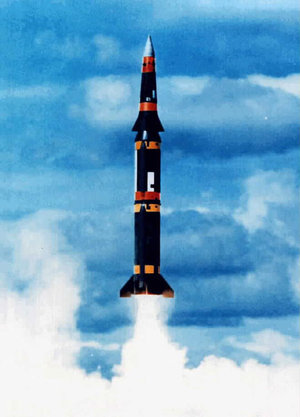MGM-31 Pershing
|
|
Army research began in 1956 and the Pershing program was awarded on a CPFF basis in March 1958 to Martin Marietta (then The Martin Company, it merged with the American Marietta Company in 1961). The first test missile, the XM14, was launched on February 25, 1960. The first two-stage launching from a tactical platform was in January 1962. The missile was given to Army units for training in 1962 and was deployed in West Germany from June 1964 in four vehicle launch platoons.
The Pershing I was 10.5 m (34 ft 7 in) long, 1.02 m (3 ft 4 in) in diameter and weighed 4,655 kg (10,275 lb). It was powered by two Thiokol TX rockets, the first stage generating 115 kN and the second stage 85 kN, total powered flight time was a maximum of 77 seconds. The range could be graduated but the maximum was 740 km (460 miles). The warhead could be conventional explosive or a W-50 nuclear warhead, yielding 400 kT.
In 1966, Martin Marietta developed the Pershing Ia, in part to replace the MGM-13 Mace missile used by the Air Force. It was a 'quick reaction alert' system and so had faster vehicles, launch times and newer electronics. It was deployed from May 1969 and by 1970 almost all the Pershing I systems had been upgraded to Ia under Project SWAP. Production of the Ia ended in 1975. In the mid-1970s the Ia system was further improved to allow the firing of a platoon's three missiles in quick succession and from any site without the need for surveying. Around 750 Pershing I missiles were built of which a maximum of 108 were deployed in Europe.
In the 1970s, the need to further refine the Pershing I became clear. It could be more accurate and for tactical considerations the 400 kT warhead was greatly over-powered. The contract to develop the replacement also went to Martin Marietta. The main difference in the Pershing II was to be a new warhead (W-85, 5-50 kT variable yield) in a manoeuvering reentry vehicle (MARV) with active radar guidance. However following early test flights in 1978 of a modified Ia the requirement of the new missile was changed, it was to be a direct counter to the new Soviet RSD-10 (SS-20) which meant that it need to be capable of reaching targets up to 1,600 km away. This required new rockets and a new light kevlar body. Although the missile's physical dimensions were kept equal to those of the Ia to retain compatibility with existing ground equipment the missile's weight was increased to 7,490 kg (16,540 lb) and the range was pushed up to 1,770 km. Almost 380 Pershing II missiles were made. They were first deployed in West Germany from January 1984 and the European deployment was completed in late 1985.
The Pershing systems were scrapped following the ratification of the Intermediate-Range Nuclear Forces Treaty on May 27, 1988. The missiles were withdrawn on October 1988; the last of the missiles were destroyed by the static burn of their rockets and subsequently crushed on May 1991 at Longhorn, Texas. The W-85 warheads used in the missiles were removed, modified, and reused in B61 gravity bombs. A Pershing II is now on display in the Smithsonian's National Air and Space Museum. The missile sits alongside a Soviet SS-20 missile.
External links
- US Army Pershing Weapon System History (http://www.redstone.army.mil/history/systems/pershing/welcome.html)
- Pershing Professionals Association (http://www.pershingmissile.org/) - veterans preserving the history of the Pershing systemsde:Pershing II

